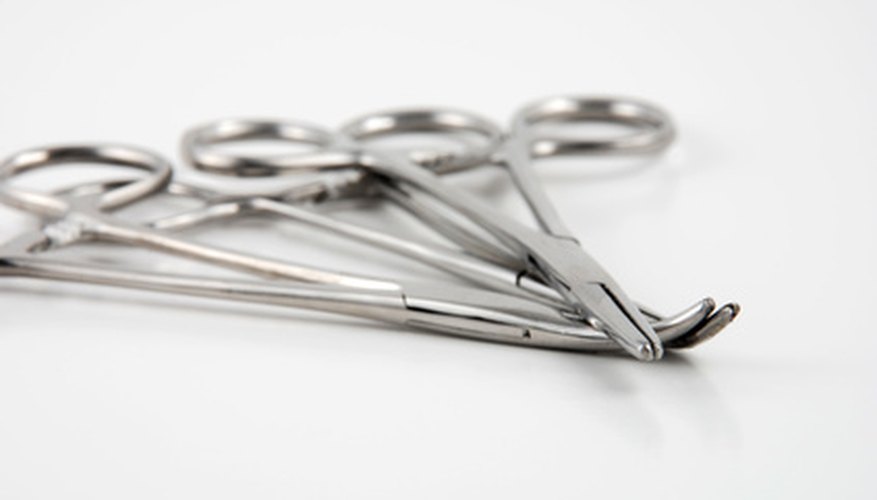There are two different collectable Giggles dolls. The first Giggles doll was sold from the 1920s to 1940s. The all composition doll was created by Cameo Doll Company and Rose O'Neill of kewpie doll fame.
The doll used a kewpie doll body. Composition is a mixture of sawdust and glue. The second Giggles doll was produced by Ideal in the 1960s.
- There are two different collectable Giggles dolls.
- The second Giggles doll was produced by Ideal in the 1960s.
This hard plastic and vinyl doll has a mechanism inside that giggles when the doll's arms are pushed together. Whether or not a doll can be repaired depends on the doll's condition and the skills of the doll restorer.
Restring Giggles by removing the damaged string. Pull out one arm and snip the old string off. The arms, legs and head feature a metal hook sunk into the composition material. Measure from the doll's neck to beneath the crotch. Divide this measurement by two. Add 1-inch to the resulting measurement. Cut doll elastic to this measurement. Tie it into a loop. Slip the loop over one leg hook. Insert hemostatic forceps through the neck hole. Feed the hook/elastic loop on the leg into the torso/leg hole. Grip the elastic loop with the forceps. Pull the loop through the neck hole. Slide a pencil through the loop to hold it over the neck. Use the forceps to grasp the loop through the other leg hole. Pull it gently out the torso/leg hole. Slip the other leg hook onto the elastic. Repeat for the arms through the arm holes. Hook the head to the elastic above the pencil. Slide out the pencil. The head will snap into the neck hole.
- Restring Giggles by removing the damaged string.
- Use the forceps to grasp the loop through the other leg hole.
Fix holes or peeling with water putty. Mix the putty to a dough consistency. Push the putty into the hole/peeling. Use your fingers or a damp rag to smooth the putty. Allow putty to dry. Sand the dried putty until level with the composition surface. Wipe sanding residue away with a damp rag. Dry the doll completely with a clean rag. Paint over the repairs with oil-based doll restoration paints available through doll repair services.
- Fix holes or peeling with water putty.
- Dry the doll completely with a clean rag.
Fix crazing (fine lines in the outer composition/paint layer) with a homemade crazing mixture of equal parts white school glue and light flesh acrylic craft paint. Use a rag to rub the mixture over the surface of the composition, pushing it into the crazing. Rub the excess away with a rag. Buff the composition surface to a shine and allow the paint solution to dry. Use caution around the face paint as the paint can easily be rubbed off.
- Fix crazing (fine lines in the outer composition/paint layer) with a homemade crazing mixture of equal parts white school glue and light flesh acrylic craft paint.
Touch up Giggles' painted eyes, hair or body paint with acrylic paint or oil-based doll restoration paints only if you have the skills necessary. Usually face repainting is best left to professional restoration services.
Wash Giggles' rooted synthetic hair in warm water with a glass cleaner or all purpose household cleaner. Rinse the hair with warm water. Spray hair detangler into the hair. Comb the hair straight. Blot dry with a towel.
Spray the doll body and limbs with a spray vinyl protector (available at automobile supply stores). Allow the protector to remain on the doll for about five minutes. Dip cotton balls into warm water to wipe the protector away. Use a toothbrush to scrub any ground in dirt. Rinse with wet cotton balls.
- Wash Giggles' rooted synthetic hair in warm water with a glass cleaner or all purpose household cleaner.
- Dip cotton balls into warm water to wipe the protector away.
Remove stains from Giggles' body or limbs by applying a cream containing Benzoyl peroxide to the stain with your finger. Place the doll in a sunny spot and leave her for about two days or until the stain fades. Wipe the remaining cream away with a wet cotton ball.
Repair the factory mechanism inside that allows Giggles to giggle by replacing the old membrane. Use a small screw driver to remove the five screws on her hard plastic back. Remove the screws from the metal guard holding the top of the circular compartment together. Notice the old rubber membrane. When Giggles' arms are pushed together the movement forces air through this mechanism causing a springlike weight to vibrate and make the giggle sound. This process resembles the old cylinder toys that are shaken to make an animal sound such as a moo. Remove the old membrane. Cut a 4-inch square of plastic from a plastic grocery bag. Place the plastic over the circular compartment, replace the lid, replace the metal guard and replace the doll's back. If this doesn't fix the mechanism, seek professional restoration services as special parts may need to be ordered.
- Remove stains from Giggles' body or limbs by applying a cream containing Benzoyl peroxide to the stain with your finger.
- Use a small screw driver to remove the five screws on her hard plastic back.
TIP
There are professional crazing repair solutions that can be purchased through doll restoration services that contain acrylic or oil-based paints and work the same way as the glue/paint solution.
